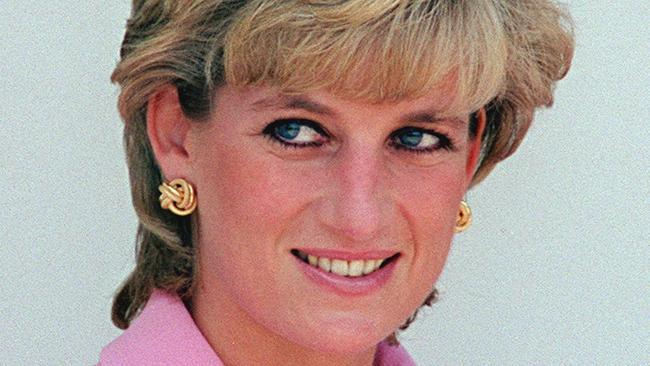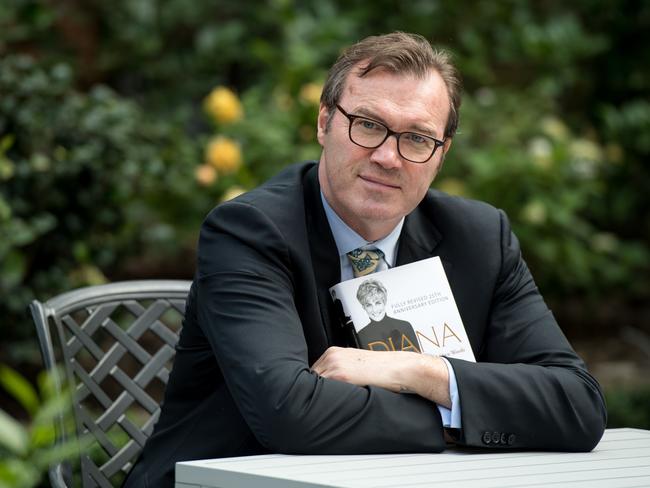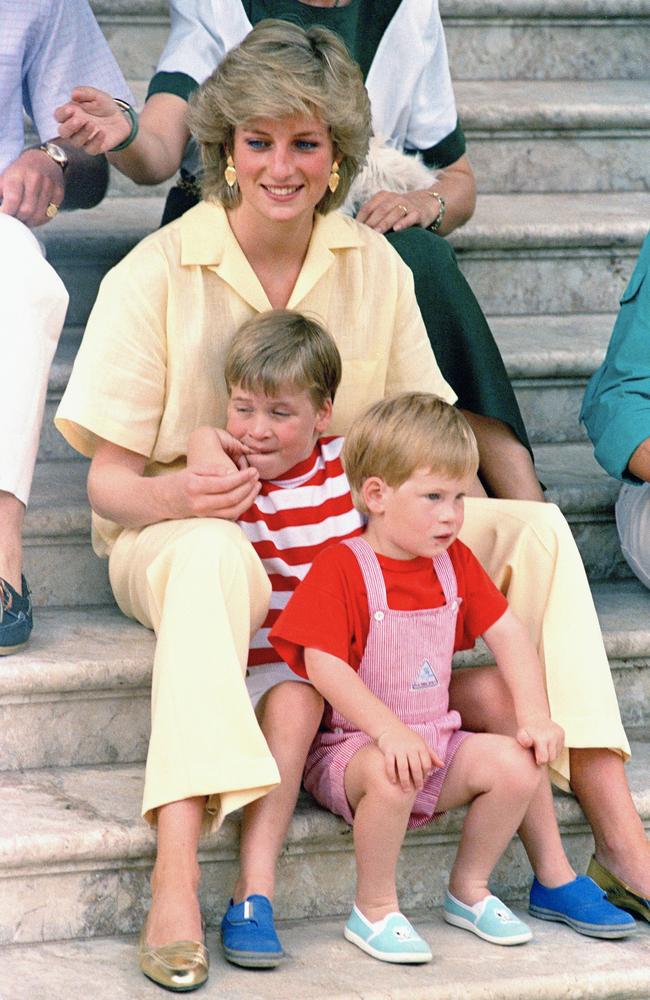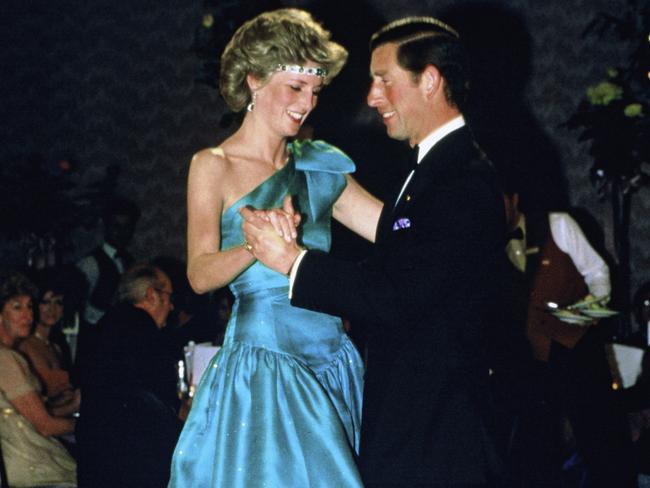Royal biographer Andrew Morton opens up about his relationship with the late Princess of Wales
ANDREW Morton, author of the only authorised biography ever written about the late Diana, has opened up about the princess’s secrets.

FOR Princess Diana, it was a terrifying baptism of fire. In April 1983, she arrived in Australia as a very nervous young woman for a six-week tour with her husband, the Prince of Wales. Just 21, the newly minted royal was petrified of facing the crowds, meeting the countless dignitaries as well as the fabled royal “rat pack,” the media circus who follow the royals around the globe.
When she walked into the media reception in the unglamorous setting of an Alice Springs hotel, she was hot, jet-lagged and sunburnt. Yet she was able to charm and captivate the representatives of the Fourth Estate. Only later did I realise that the tour was utterly traumatic. Back in the privacy of her hotel room she cried her eyes out, unable to handle the constant attention. She wanted to go home. She wanted to hide, overwhelmed by the size of the crowds in a nation gripped by Di-mania. But she survived.
It was my first major tour as a royal writer and my first encounter with the Princess of Wales, long before she became my confidant. Years later she explained her secret to me. “I’ve got what my mother’s got. However bloody you’re feeling, you can put on the most amazing show of happiness.”
It didn’t help that Prince Charles, the former top of the billing, was reduced to a walk-on part, the crowds groaning when he came to their side of the road during their many visits. As Diana told me: “He was jealous; I understood the jealousy but I couldn’t explain that I didn’t ask for it.”

These comments came much later when she was secretly collaborating with me for the biography, “Diana: Her True Story,” which lifted the lid off her unhappy marriage.
Before then I had met her at various media receptions around the world where the conversations were light, bright and trite — normally about my loud ties.
She always had a fizzy sense of humour, ready to prick the merest hint of pomposity. I remember chatting with her during a visit to Victoria Island just outside Vancouver. The July 1986 marriage between Prince Andrew and her friend Sarah Ferguson, later Duchess of York, was imminent. I proudly informed her that my Scottish ancestors were remotely linked to the Ferguson clan.
She carefully looked me up and down and said, with a twinkle in her eye: “I am sure Sarah will be thrilled!”
Her look was much more conspiratorial when we met years later in July 1991 at the Royal Albert Hall in central London where I was part of the audience enjoying a performance of Verdi’s Requiem, one of her favourite pieces of music. By then she was in frequent and secret communication with me through an intermediary, answering my questions about her life for her biography. So while we chatted gaily at a reception afterwards she shot me several searching looks that said: “Is everything OK?”

At that time we enjoyed a truly bizarre relationship. Just months earlier, the world’s most glamorous royal had started revealing the most intimate secrets of her life to a relative stranger.
It was a conspiracy that began in the unlikely setting of a working men’s cafe in an anonymous north London suburb.
It was here that I was inducted into Diana’s secret world.
I put on a pair of headphones and the man sitting opposite me, Dr. James Colthurst, pressed the “play” button of a battered tape recorder. For 20 minutes or so I listened as the familiar voice of the Princess of Wales spilt out a tale of woe: her loneliness; her desperation; her husband’s relationship with a friend’s wife, Camilla Parker Bowles; her illnesses; and suicidal impulses.
This was in the spring of 1991 when the world still believed in the royal fairy tale. Though I had been writing books and articles about the royal family for 10 years nothing prepared me for this.
When the tape recorder was switched off, it was like I had been given a glimpse into a parallel universe. My head swirling, I headed home, careful to stand well back from the platform edge before boarding the subway. Thoughts of the paranoia that infected the movie “All the President’s Men,” about President Nixon, the Watergate break-in and based on the investigation and book by reporters Bob Woodward and Carl Bernstein were not far from the surface.
The man with the tape recorder, Dr. Colthurst, a longtime friend of the princess and myself, was the crucial link. He agreed, at first reluctantly, to go to Kensington Palace, Diana’s London home, and interview her by proxy, asking her my questions and tape-recording her answers. As I was a well-known royal writer — Diana nicknamed me “Noah” after the New York Times described me as a “notable author and historian” — it would have been impossible to enter the royal palace without being spotted.

Why did she undertake such a reckless course of action? I think she wanted to give the world an insight into her life, which was, in her opinion, a lie. While she appeared in public with Charles, the princess was effectively living on her own while he tarried with his mistress. It was intolerable.
“She felt the lid was closing in on her,” recalled Colthurst. “Unlike other women she didn’t have the freedom to leave with her children.”
During this extraordinary year of secrecy and subterfuge, Diana spoke freely about her life in six long tape recordings. As I was a 6-foot-4 royal writer, I was hardly inconspicuous. So walking into Kensington Palace was out of the question as far as I was concerned. However our mutual friend, Dr. James Colthurst, who had known her since their single days, was the answer. I gave him a sheaf of questions and he would cycle to Kensington Palace, where Diana lived, for a cup of tea and a biscuit. He and the princess would convene in her sitting room, he would place a microphone on her and ask her my questions. While there was no opportunity for immediate follow-ups, if she was in an energetic frame of mind, usually in the morning, she would speak freely and openly about her life inside the royal family. She was amazingly frank, on one occasion, after I asked her questions about her suicide attempts, which she had mentioned at the last session. She treated it as a joke. “Andrew’s pretty well written my obituary,” she told Colthurst.
Yet as candid as she was, she was never entirely frank. While she raged against her husband’s affair with Camilla, she hid the fact that she had enjoyed a long, if sporadic, love affair with Major James Hewitt, a fling with old friend James Gilbey and was pursuing a married art dealer during the writing and research of “Diana: Her True Story.”

Looking back, her audacity was breathtaking though she subsequently argued that because Charles strayed first she was left with no alternative but to find comfort in the arms of others.
As the project gained momentum, Colthurst and I dealt with more than just the book. Everything from advising her on what to talk about to former Secretary of State Henry Kissinger over lunch, the then-French President Francois Mitterrand over dinner or rewriting her speeches was all part of the daily agenda. The speeches meant a lot to her, she was thrilled if there had been coverage in the media. She was desperate to be seen as a workhorse, not just a glamorous clotheshorse.
It was an exhilarating time, helping to shape the future of one of the world’s most famous young women right under the noses of Buckingham Palace and the mainstream media.
There were times, though, when we were just supporters helping a friend in difficulty. In the summer of 1991 for example, when Prince William suffered a depressed skull fracture after a schoolmate accidentally hit him with a golf club, the princess was simply a worried mother concerned about her son. She stood in the hospital corridor pumping coins into a phone box — these were the days before ubiquitous mobile phones — quizzing Dr. Colthurst, a qualified surgeon, for his opinion on her son’s delicate condition. That episode summarised her domestic situation.
She remained with her son in the hospital while Prince Charles went off to the opera to fulfil a public engagement.

During this year of living dangerously we were constantly reminded that this was a high-stakes, winner takes all game. Diana was paranoid about what she called “the men in grey,” shadowy establishment figures linked to Britain’s equivalent of the CIA. She was worried that one of us would be compromised in some way.
When Colthurst was knocked off his bicycle while carrying his precious cargo of tape recordings from Kensington Palace, Diana feared the worst. She insisted we buy scrambler telephones — and to be extra sure she had her sitting room at Kensington Palace swept for bugs. Diana had every right to be concerned. Shortly after I had written a well-sourced article about the Prince and Princess of Wales, my office was broken into, files rifled through but nothing of interest except a camera stolen.
A few months after the publication of the book in June 1992, Diana’s private late-night conversation with her then-lover James Gilbey was made public. Once again the princess strongly suspected that the dark forces in the establishment were behind this manoeuvre in order to discredit her in the eyes of her adoring public.
By then what Diana called the “eruption of the volcano,” the publication of her biography, had taken place. As we had given her deniability by not naming her direct involvement she was able to have clean hands. At the same time she could support the book’s message by visiting those friends who had spoken to me.
In the months and years following the book’s publication in June and her subsequent separation in December 1992, we kept in touch, offering general advice and counsel about her future direction inside and, ultimately, outside the royal family. We suggested, for example, that she find herself a house in the country so that her growing sons, William and Harry, could roam more freely than at Kensington Palace. She called them “the killer Wales” as they loved rough shooting on country estates.
For me the tragedy of her life is that in the final months Diana had finally got her life together. She looked great, she had said goodbye to her former royal persona and was embracing a future as a glamorous and articulate humanitarian. A princess for the world rather than a Princess of Wales.
Sadly, the light at the end of her long tunnel was the staccato blur of the paparazzi flashbulbs.
Andrew Morton is the author of “Diana: Her True Story,” the only authorised biography ever written about the late Diana, Princess of Wales.
This article originally appeared in the New York Post and was republished with permission.



